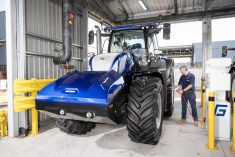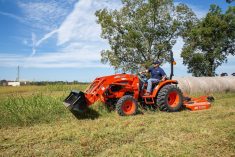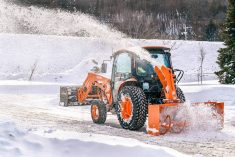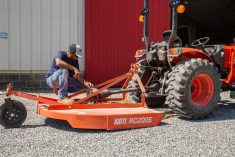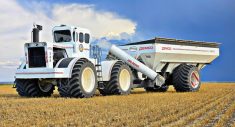In 1966 Versatile began producing tractors with the G100 and D100 models. That was 50 years ago, so 2016 is the year this brand gets to celebrate a golden anniversary. And it isn’t going to let that milestone pass unnoticed.
As part of the celebrations, Versatile has arranged to bring home the most recognizable tractor ever built at its Winnipeg assembly plant, the eight-wheel drive model 1080, which became known as “Big Roy.” It was named after Roy Robinson, co-owner of the company and lead designer on the 1080 project. The tractor was previously donated to the Manitoba Ag Museum in Austin, and it will eventually be returned there.
Read Also

Cancer agency reclassifies another herbicide ‘probably carcinogenic’
The WHO’s cancer research agency has now put atrazine, a herbicide well known to corn growers, in the same potential-hazard category where the agency put glyphosate.
The one-off 1080, which was built in 1977, will undergo a complete restoration at the same Winnipeg plant where it was built to prepare it for a new season of touring, something it first did nearly 40 years ago. When the restoration is completed, Big Roy will be a prime attraction at Versatile machinery displays at farm shows this year, starting with the Ag in Motion event near Saskatoon in July.
As you’d expect, completely restoring a tractor on the scale of the 1080 is no small job. The crew working on it will expend a few thousand man hours of work to get the job done. But it’s scheduled for completion by the spring.
Versatile has given Grainews an exclusive backstage pass to document the restoration process. The Grainews video team has already made a couple of visits to the plant to film the initial tear down and start of repairs. You can find the first video episodes in the Big Roy series online under the “videos” link at Grainews.ca.
One of the things we found most remarkable about the restoration is that one of the company employees working on the tractor now was actually involved in building it back in 1977. So he brings a lot of expertise to the process.
With all of this happening, we thought it was good time to not only take a detailed look at how the tractor was built, but also look back to when and why.
- Photo gallery: Getting “Big Roy” ready for restoration
Picking the design
With four drive axles and 605 engine horsepower, there wasn’t anything like the 1080 on the market in the mid-1970s. “We were looking at what’s the best way to put that much power to the ground,” remembers Mark Oleski, a former production engineer involved with the original 1080 project. Eight-wheel drive seemed like a good way to do it at the time.
“We didn’t want to be a me-too design,” says Arnold McCutcheon, another engineer who worked on the hydraulic system design and field-testing of the 1080. “There was already Big Bud.”
“We were looking to see if we could get into another niche market,” adds Oleski. “They (Versatile’s management) decided an eight-wheel drive tractor would be an important stake in the ground.”
Having more than two axles, though, did solve one problem experienced by the mega-tractor builders of the time: Big Bud and Wagner. When their tractors, which were already very wide, were equipped with dual wheels, it made road transport difficult. But things were very different with Big Roy. “You didn’t need duals,” says McCutcheon. “For transport on the road, it was an absolute cinch. It would load nicely on a transport truck.”
However, getting all the necessary drive components to fit into the 1080’s relatively narrow chassis called for some creative engineering. They took up a lot of space, limiting the design options. And in an industry first, those four axles were mounted on coil springs. That made Big Roy the first articulated tractor to be built with standard suspension.
Taking Big Roy from the drawing board to the field didn’t take long. “My hunch is it was a matter of months rather than years,” remembers McCutcheon. “It happened pretty fast.”
Estimates suggest that the tractor would have had to sell for about $130,000 in 1977 (about $471,000 in today’s dollars). That was an enormous amount for the time, considering the firm’s popular model 900 retailed for only about $50,000.
Here is a look at the initial teardown, which was completed in January. Watch for more photos here in the pages of Grainews, as well as more e-QuipTV episodes online, as the restoration process continues.




